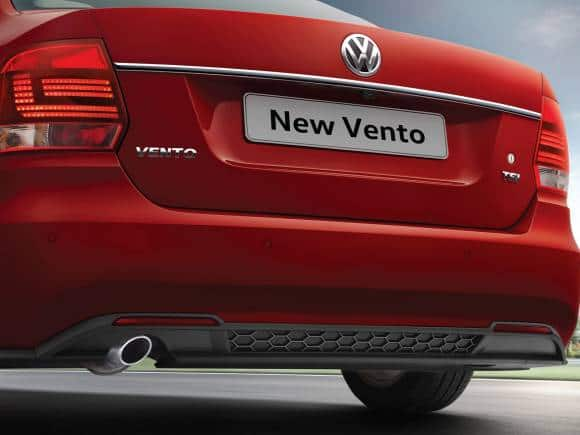



The new Volkswagen Vento is an odd car to behold, in light of the bold, cutting-edge direction that VW India happens to be taking. The design still looks solid but staid, and the reworked bumper doesn’t seem like a strong enough effort to hold its own against increasingly sophisticated competition.
With the arrival of the T-Roc (albeit through CBU route) we have a glimpse of the sort of design and tech that Volkswagen can offer. So is the new Vento a significant enough step forward, or the dying gasp of a once-loved sedan?
In with the oldIt’s much the same on the inside. Familiarity might be comforting to some, but when it comes to popular cars, new is always the way to go, at least visually.
The Vento’s interiors are a familiar mix of beige and black with standard quality plastics that give the cabin a reliable and wholesome air. While the layout stays the same, it does get Apple CarPlay and Android Auto connectivity (via a USB cable) although the lack of additional USB ports, once again, points towards minimal changes.
The cubby holes could have been bigger, as could the size of the phone holder placed inside the armrest. That said, this isn’t as barren as you might think. The top-end Volkswagen Vento TSI (Rs 13.39 lakh, ex-showroom) gets all the bells and whistles one can expect from a contemporary, mid-sized sedan. LED headlamps, rain-sensing wipers, active cruise control, four airbags and a reversing camera – it’s decently kitted out.
Of course, it also has a centrally-mounted touchscreen, but at 5-inches, it’s decidedly smaller than what the competition offers. Smaller, isn’t necessarily lesser. This appears to be the underlying theme of this car because the screen feels more tactile, responsive and legible than some of the glossier options out there.
And anything that errs on the side of practicality, is, in my eyes, a win.
Smaller engine, greater powerThe main talking point about the car is the new 1.0-litre, three-cylinder turbo-petrol engine. Pushing out 110hp, it’s more powerful than the previous 1.2-litre motor, by 5hp, gets a 175Nm of torque and loses the slick 7-speed DSG gearbox for a standard torque-converter six-speed unit.
The former unit, while being seamless did cost a fair bit to maintain. And the new Vento ditches its lofty ambitions in order to serve the need of the hour: to be an affordable and robust mid-sizer. And the new unit feels surprisingly responsive, diligently managing the pre-2000 rpm turbo-lag, throwing dollops of torque at low revs, making the car feel very quick from a standstill.

You’re not thinking of the absence of a cylinder, you’re not thinking of the diminished cubic capacity. You’re only thinking of how much fun this thing can be, for a front-wheel driven family car. So there you have it, another win for the Vento.
I haven’t driven the six-speed manual yet, but given how torquey and sprightly this motor is, a manual gearbox comes with the added benefit of a lowered price tag and a more engaging drive.
The six-speed auto for it’s part, is considerably better than the CVT option offered in the Honda City. No matter the revs, you get the sense that the box is working with you, and not trailing behind at every step.
The VW factorFor all the talk of sensational design and neon-bathed interiors, what ultimately matters is how well-built a car feels.
And in that department, the VW always takes the prize. Visually, not much appears to have changed, but what also hasn’t changed is the fact that the Vento gets its basics right.
The steering has a certain weight to it, that would be anathema to many other carmakers, but that makes the drive more precise, more engaging. There’s a level of insularity that only the Vento (or its cousin, the Skoda Rapid) can offer.
Corner hard, and the way it tackles gravity is noticeably different from its Japanese or Korean competition. And it does so without feeling tightly wound or stiff in on topographically challenging terrain, aka our roads.
VerdictThe Vento may look its age. But it was always designed to be ahead of its times, and as a result continues to hold up really well.

With prices starting from Rs 8.93 lakh (ex-showroom, for the entry-level manual “Trendline”) and going all the way up to Rs 13.39 lakh for the top-end automatic “Highline Plus” version, there are plenty of options to choose from.
The manual version seems like a safe bet, if you want a more affordable option (an on-road price of Rs 15.87 lakh for the AT “Highline Plus” and Rs 14.46 lakh for the “Highline” can serve as a major deterrent for some).
But if it’s the automatic you’re keen on, the new unit for its money, seems more reliable than the DSG, even if it doesn’t shine quite as bright. The Vento, however, continues to retain its qualities as a well-built and engaging car.

Discover the latest Business News, Sensex, and Nifty updates. Obtain Personal Finance insights, tax queries, and expert opinions on Moneycontrol or download the Moneycontrol App to stay updated!
Find the best of Al News in one place, specially curated for you every weekend.
Stay on top of the latest tech trends and biggest startup news.